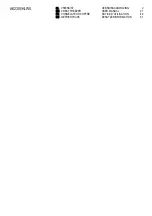
38
With the system started
After following instructions on the previous page on initial Charging for Systems with Head
Pressure Control, with refrigerant tank now connected to suction line (low side) port to add
remaining charge in a gas state, refer to the provided charts for proper system operating points
as equated to ambient temperature with wine cellar at normal conditions of 57 degrees F /
55%RH. Refer to Split Systems Operations chart on page 39 for system pressures, sub-cooling,
and superheat values to allow you to charge your system correctly.
In addition to using the charts provided, there is a liquid line moisture/sight glass located in the
condensing (outdoor) unit that will assist you in knowing that you have sufficiently charge
your system, HOWEVER a full sight glass or a glass with bubbles does not necessarily mean
you are properly charged, or undercharged. There may be other factors affecting sight glass, so
do not charge by sight glass method only. A full sight glass- matched with proper system
pressures, sub-cooling, and superheat values is the proper method for confirming that the
system charge is correct for your application.
If you are not sure how to measure superheat or sub-cooling
:
Superheat
Get an accurate suction line temperature on the suction line as close to the compressor inlet as
possible. At same time, attach a compound pressure gauge set to the system so as to read the
low side suction pressure at the suction service valve port (back seated valve stem to allow un-
restricted refrigerant flow from evaporator back to the compressor). Convert suction pressure
to a saturated temperature as derived from a pressure/temperature chart. Since the suction line
temperature is the higher value, subtract the saturated temperature from it to derive your
superheat. If your wine cellar is already at specified conditions (e.g., 57 degrees F, 55% RH),
and if your superheat is very low, or zero, you may have overcharged your system.
Sub-Cooling
With your compound pressure gauge set still installed with the high side connect to the valve
port on the liquid receiver (back seated valve stem to allow un-restricted refrigerant flow from
condenser to evaporator). Convert this liquid pressure to a saturated temperature from
pressure/temperature chart. Next, obtain your liquid line temperature by getting an accurate
reading on the liquid line BEFORE the TXV expansion on the indoor side. Obtain this
temperature entering the evaporator unit. Subtract the liquid line temperature from the
saturated liquid temperature to derive the system sub-cooling.
When comparing your high side system pressure to supplied charts below, refer to the liquid line
pressure.
To give you an idea on how much R134A refrigerant charge you may require to reach full charge
for your given interconnecting line length, see the very general guidelines below based on liquid
line size:
SS025, SS050
1/4” OD ~ .50 ounce/foot
SS0088, SS200
3/8” OD ~ 1.0 ounce/foot
**Based on factory testing using 25 feet of interconnected piping
SS025 = 35 ounce total charge
SS050 = 39 ounce total charge
SS088 = 60 ounce total charge
SS200 = 73 ounce total charge
Содержание 15H0128-00
Страница 11: ...11 Fig 2 Overview of the Wine Guardian fan coil Fig 1...
Страница 13: ...13 Ducted split system specifications sheet...
Страница 14: ...14 Wiring Diagram for SS025 and SS050 Units Fig 4...
Страница 15: ...15 Wiring Diagram for SS088 Units Fig 5...
Страница 16: ...16 Wiring Diagram for SS200 Units Fig 6...
Страница 17: ...17 24 Volt Contactor Detail Sheet Fig 7...
Страница 27: ...27 Rod Mount Fig 2 Shelf Mount Fig 3 Optional ductwork connection on same wall Fig 4...















































